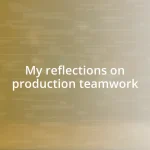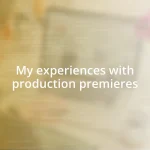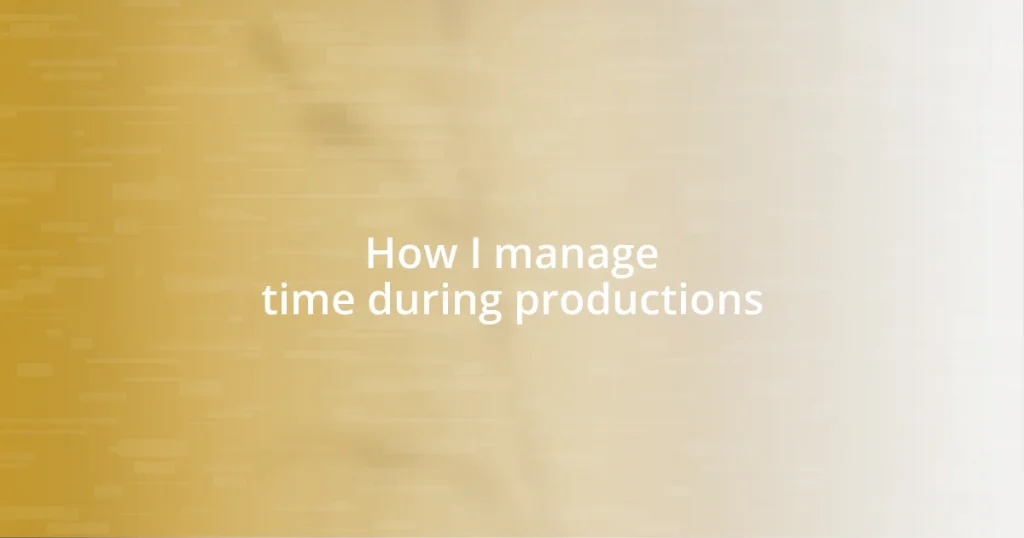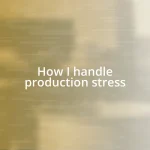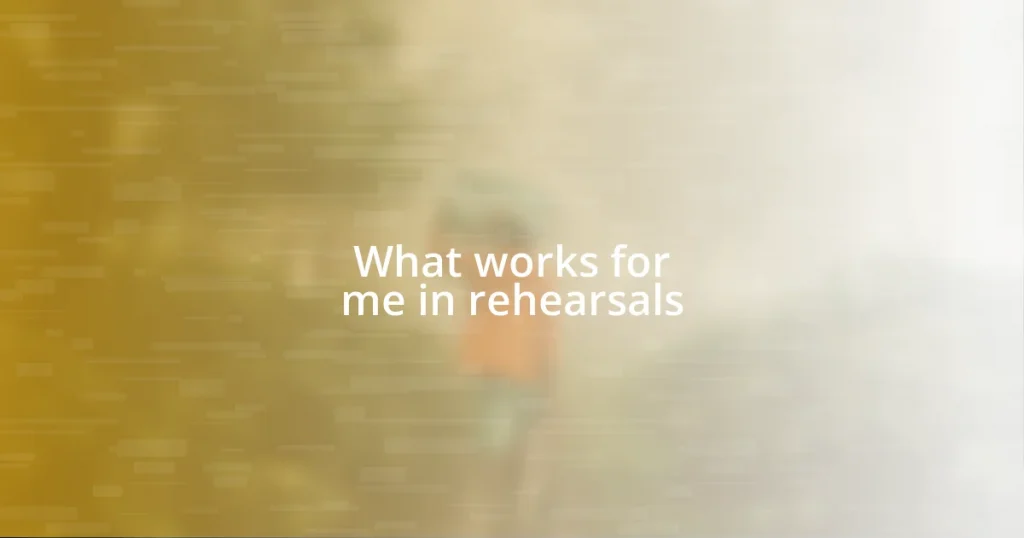Key takeaways:
- Effective production time management combines structure with flexibility, allowing creativity to flourish while maintaining organization.
- Setting clear, specific, and measurable production goals facilitates a streamlined workflow and helps teams stay focused and accountable.
- Regular monitoring of progress and reflective practices post-production enhance adaptability and foster continuous improvement for future projects.
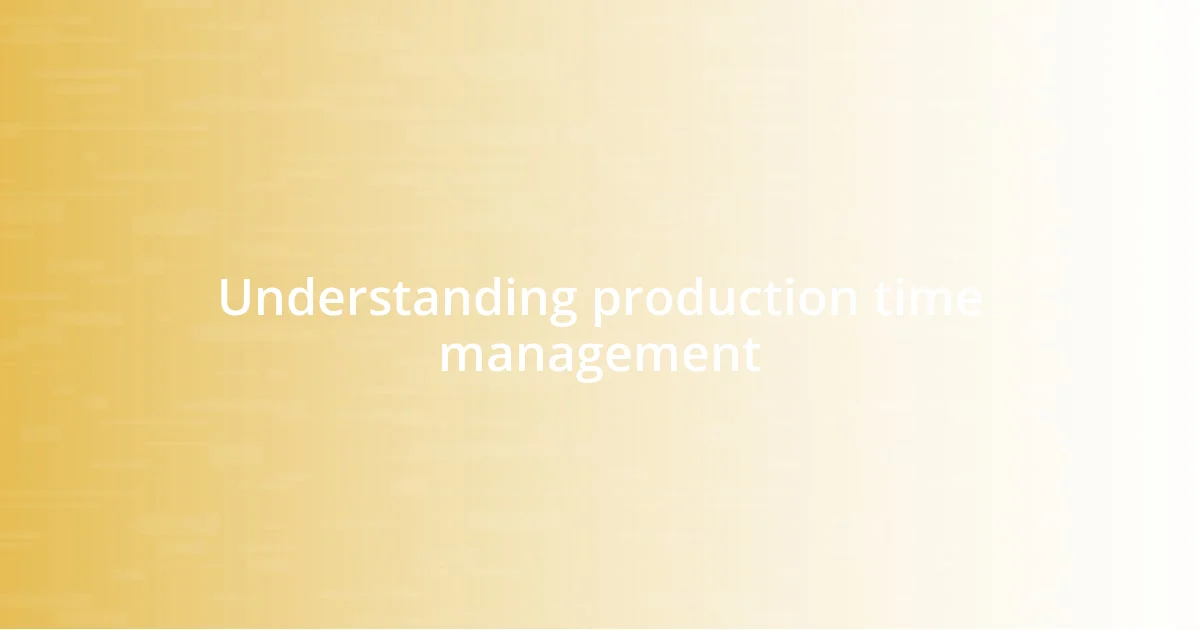
Understanding production time management
Production time management is not just about meeting deadlines; it’s about creating a workflow that allows for creativity while staying organized. I remember when I first worked on a large-scale project. I was overwhelmed by the timelines, and it hit me that without proper management, even the best ideas could fall flat. Have you ever felt that pressure? The key is to build a schedule that permits both structured tasks and leeway for inspiration.
One of the most effective tools I’ve found is breaking down the entire production process into smaller, manageable parts. This way, I can track progress without feeling disheartened by the enormity of the final deadline. For instance, when working on a recent documentary, I broke down each segment into scriptwriting, filming, editing, and review phases. I made it a point to celebrate small wins along the way. It sounds simple, but acknowledging these milestones motivated me tremendously.
Additionally, I always set aside time for unexpected hurdles; they inevitably come up. By anticipating obstacles, I can maintain a sense of control and calm. Last week, a key interviewee postponed their session, and instead of panicking, I redirected that time to refine our visuals. How do you handle surprises? I think the secret lies in resilience and flexibility, which are pillars of effective production time management.
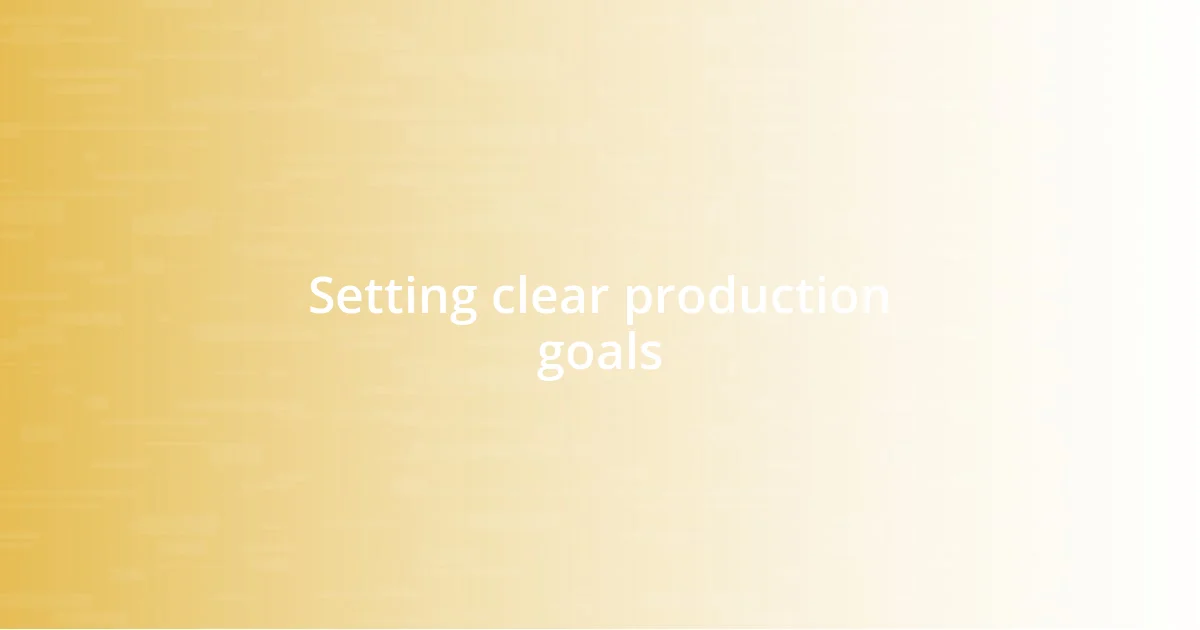
Setting clear production goals
Setting clear production goals is essential for a streamlined workflow. When I started managing larger productions, I quickly learned that vague objectives can lead to chaos. I remember one project where we had a great concept but no clear goals. We ended up running in circles, wasting time, and missing crucial deadlines. Since then, I’ve adopted a simple principle: define specific and measurable goals from the outset. This clarity not only guides the team but also serves as a motivational anchor.
Here are some tips I follow for setting effective production goals:
- Be Specific: Instead of saying “improve the visuals,” aim for something like “incorporate drone footage in two key scenes.”
- Make It Measurable: Set targets like “complete the first draft of the script by Friday,” so the team knows exactly what to achieve.
- Stay Realistic: I’ve learned to ground my goals in reality, considering resources and time limits to avoid burnout.
- Set a Deadline: Assign a timeline for each goal. I find that having a firm date makes everyone more accountable.
- Revisit Regularly: Goals shouldn’t be static. I often assess them during production meetings and adjust based on feedback and progress.
By embedding these clear goals into the production plan, I’ve seen teams rally with renewed focus and creativity. It’s almost like transforming a jigsaw puzzle from chaos into a neatly organized masterpiece.
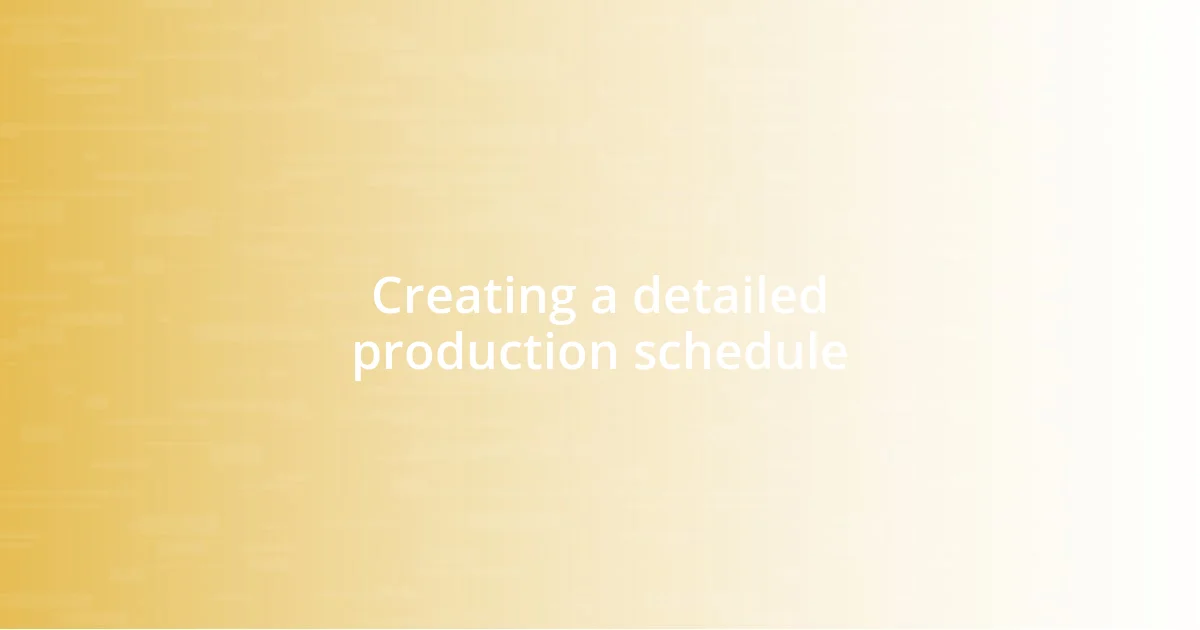
Creating a detailed production schedule
Creating a detailed production schedule is where the magic truly begins. I often think of my schedule as a roadmap; without it, I risk getting lost on the journey. For example, during one project, I was tasked with launching a new series in just three weeks. I developed a day-by-day timeline, organizing key tasks like location scouting, casting calls, and editing deadlines. Each day had specific goals, which helped the entire team stay on track and fostered open lines of communication. It’s a bit like a dance—everyone needs to know their steps to keep the rhythm flowing smoothly.
On that note, I find that including buffer periods in my schedule is crucial. These are little cushions of time that allow for unforeseen events, like weather changes or last-minute location adjustments. I remember one shoot where we faced unexpected rain, which delayed our outdoor scenes by a day. However, because I had built in some flexibility, we seamlessly shifted tasks, filming indoor scenes instead. This adaptability not only saved the production but also kept everyone’s spirits up, reinforcing a collaborative team environment.
Lastly, I use various tools to enhance my scheduling efforts. For instance, I rely on project management software to track each task and its completion status. It’s a great way to visualize progress, but I also like to have a physical copy of my schedule on hand. There’s something rewarding about crossing off completed tasks with a pen. How about you? Have you ever had that satisfying moment when you finish a tough phase? I look at scheduling not just as a necessity but as an art form, blending discipline and creativity.
| Aspect | Description |
|---|---|
| Scheduling Method | Paper vs. Digital Tools |
| Benefits | Flexibility and visualization |
| Impact on Team | Encourages collaboration and accountability |
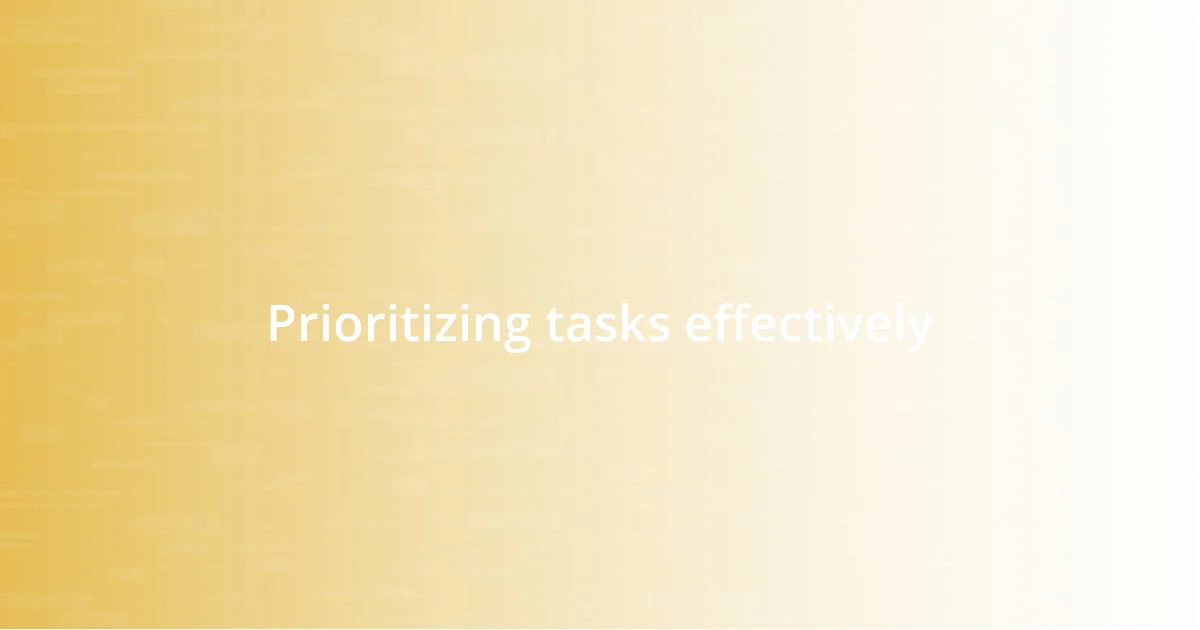
Prioritizing tasks effectively
Prioritizing tasks effectively is crucial when juggling multiple responsibilities during production. In my experience, I often categorize tasks based on urgency and importance. For instance, when I was working on a music video shoot, I made a list of everything from location permits to talent availability and grouped them accordingly. This made it clear that securing the venue was a top priority, while minor details could wait. Have you ever felt overwhelmed by choices? I know that feeling well, and I’ve found that consciously breaking tasks down eases the pressure.
One technique that has worked wonders for me is the Eisenhower Matrix, a tool for decision-making. It helps differentiate between what’s urgent and what’s important. I recall a time when my team was torn between editing footage and preparing a pitch for an upcoming project. Using the matrix, we realized the pitch was time-sensitive and crucial for future funding, thus needing immediate attention. This clarity helped us allocate resources efficiently and maintain our project’s momentum.
Additionally, I believe in the power of delegation. I often analyze each task and determine who on my team is best suited to handle specific responsibilities. For example, during a large production, I assigned my assistant to coordinate prop management while I focused on directing. This not only empowered my team but ensured that every task received the appropriate attention it deserved. How do you approach delegation in your work? I find that trusting my team often yields unexpected results and enhances creativity within the group.
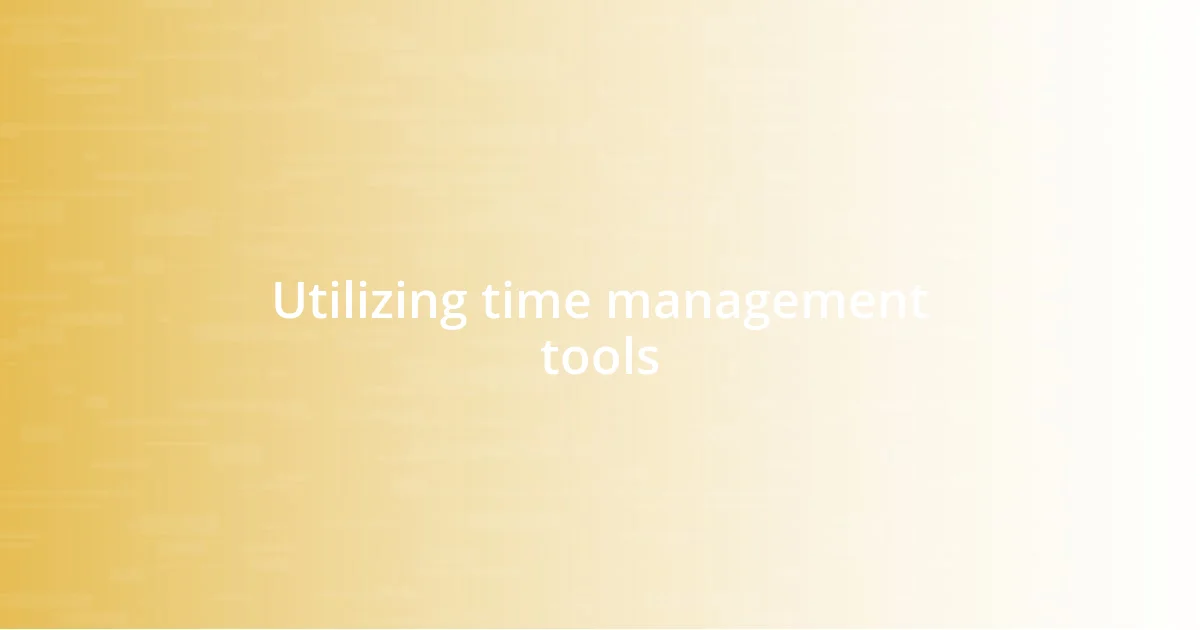
Utilizing time management tools
Utilizing time management tools can transform the chaos of production into a more organized experience. For me, digital calendars are indispensable. I remember one intense week where we were juggling several shoots simultaneously. By inputting all deadlines and appointments into Google Calendar, I not only kept track of critical dates but also set reminders an hour before each event. It felt great knowing I had a fail-safe that nudged me just when I needed it.
However, software alone isn’t enough. I’ve found that collaboration tools like Slack keep communication fluid among the team. Once, during a particularly hectic filming day, I sent out a quick message to check on everyone’s status. This instant feedback helped me adjust our shooting schedule on the fly, proving that time management isn’t just about planning ahead—it’s also about being flexible and responsive in the moment. Have you ever experienced a situation where a quick communication saved the day? Those moments remind me of the power of teamwork and real-time adjustments.
Lastly, using task management apps like Asana has been a game changer for tracking progress on long-term projects. I recall when we launched a documentary series—it was a monumental undertaking. Each week, I organized tasks by deadlines and assigned them to various team members. Watching that progress bar fill up was not just satisfying; it kept everyone motivated. Isn’t it amazing how visual accountability can inspire a team? These tools not only streamline production but also create a shared sense of accomplishment that fuels our creativity.
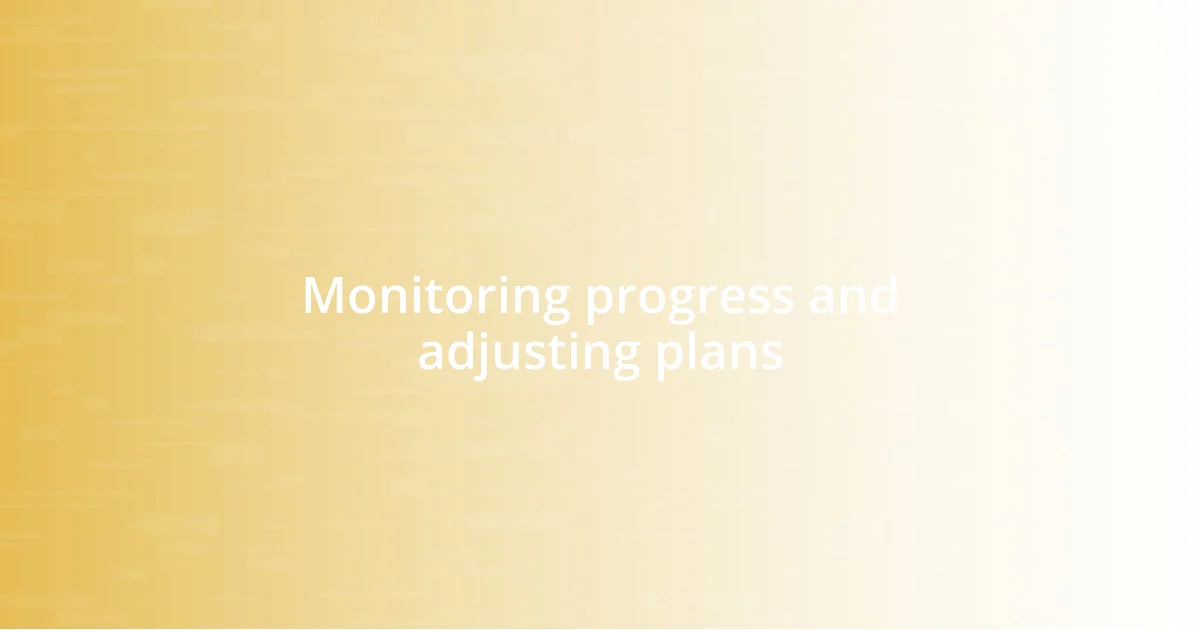
Monitoring progress and adjusting plans
Monitoring progress is an essential part of keeping productions on track, and I’ve learned to check in regularly with my team. For instance, during an ambitious feature film project, I would schedule short, daily stand-up meetings to assess where everyone was at. It was fascinating to see how a few minutes of open dialogue could reveal roadblocks and inspire new ideas. Have you ever noticed how small conversations can shift the direction of your work? It’s those moments that remind me of the importance of staying connected with my team.
Adjusting plans based on progress is equally crucial. I vividly recall a short film where our original filming schedule went out the window due to unexpected weather changes. Instead of panicking, we gathered to brainstorm alternatives—what if we shot indoor scenes that had been set aside? This flexibility allowed us to maintain momentum, even in the face of challenges. Have you ever had to pivot your plans at the last minute? I find that embracing change can often lead to unexpected, creative solutions.
Lastly, having a system for monitoring progress plays a key role in adjusting plans effectively. When I coordinate a project, I keep a visual project board where each task is mapped out. This not only keeps me organized but also helps my team feel accountable. I once managed a marketing campaign where tracking our social media engagement weekly revealed which strategies weren’t hitting the mark. Instead of sticking to the plan, we capitalized on successful avenues. Making adjustments based on what the data showed us felt empowering, encouraging an environment where adaptability became second nature. Doesn’t it feel great to turn insights into action?
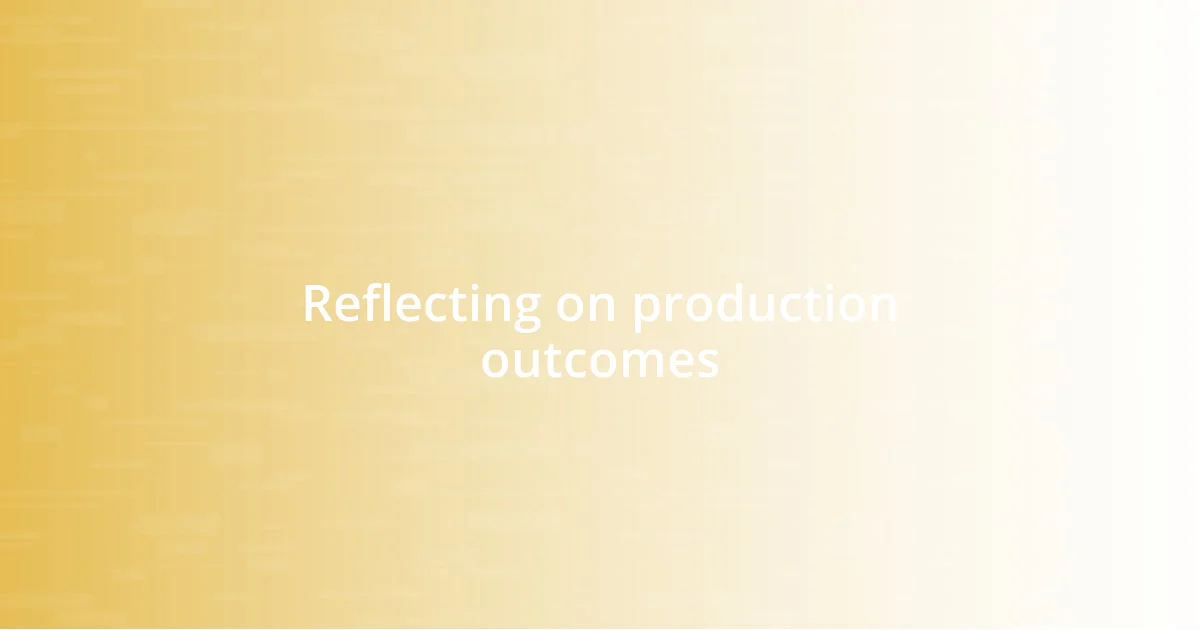
Reflecting on production outcomes
Reflecting on production outcomes means looking back to assess what worked and what didn’t. After a challenging project, I often find myself brainstorming during those quiet post-production moments. For example, after finishing a large campaign, I sat in a café, revisiting our original objectives alongside the final output. What I discovered was enlightening—some strategies exceeded our expectations, while others barely made a dent. This kind of reflection not only celebrates victories but also highlights areas for improvement. Have you ever felt that mix of pride and learning as you evaluate past efforts?
When I examine production outcomes, the emotional aspect truly stands out. I remember wrapping up a documentary that was deeply personal to my team and me. In the weeks that followed, discussions with the crew revealed a sense of camaraderie and pride, but also some bewilderment over certain decisions we made. Why did we choose that particular shot over another? Reflecting on the pride and slight confusion in that experience has taught me that sometimes the choices that seemed right during production may need reevaluation in hindsight. How often do we romanticize our past decisions, only to realize later that growth comes from understanding their context?
It’s also vital to document these reflections. Following another intense production, I created a feedback loop with my team where we shared insights and critique in a casual setting. We used an anonymous digital form to gather thoughts, which allowed everyone to voice opinions without hesitation. This contributed to a frank discussion about our processes, revealing hidden inefficiencies that we hadn’t noticed in the heat of production. Isn’t it interesting how closed feedback systems can lead to breakthroughs ahead of future projects? Through this process, I learned that thoughtful reflection lays the groundwork for future success and fosters a culture of open communication.







